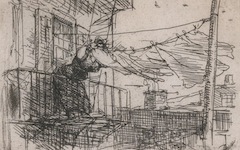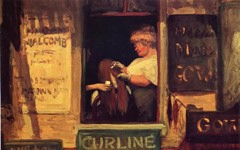Sloan’s Portrait of George Sotter (1902)

John Sloan, Portrait of George Sotter (1902) Oil on canvas. Private Collection.
Click image to enlarge.
Appearances, as always, are deceptive. In this painting from 1902 John Sloan depicted a now little-known painter, George Sotter, at work on a canvas. It is particularly clever because, natural though it seems, Sloan has depicted Sotter not just as if Sotter was painting a picture (unseen) but as if Sotter himself had painted this picture! In other words, John Sloan has imagined himself as George Sotter.
Click next thumbnail to continue

Top L: Sloan's Portrait of George Sotter (1902)
All other images are self-portraits by, clockwise from top right: Whistler (c.1872), George Stubbs (1781), Ingres (1864-5), Elizabeth Vigée-Lebrun (1800) and Balthus (1940).
Click image to enlarge.
Sloan has painted his sitter in the pose that so many great artists have taken when painting their own self-portraits. They are, of course, looking in a mirror while painting their self-portrait on an unseen canvas. That's why they face to one side with their arms (if seen) parallel to the picture plane with a hand near the far edge. The implication is, of course, that while Sloan may not have used a mirror to paint Sotter he has imagined the surface of the image as if it was a mirror in line with hundreds of other artists over the centuries, most notably in my opinion in Velazquez's Las Meninas (1656) and Manet's Olympia (1863).
George Sotter is a reflection in Sloan's mind in the process of creating (off to the right) the exact image we see. In identifying with his sitter Sloan conveys that he is both artist and model, subject and object. In identitifying with another artist though, he seems to suggest that artists share a similar mind, similar poetry and similar challenges.
More Works by Sloan
Notes:
Original Publication Date on EPPH: 26 Oct 2013. © Simon Abrahams. Articles on this site are the copyright of Simon Abrahams. To use copyrighted material in print or other media for purposes beyond 'fair use', you must obtain permission from the copyright owner. Websites may link to this page without permission (please do) but may not reproduce the material on their own site without crediting Simon Abrahams and EPPH.


